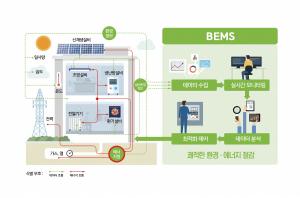ICT-based’Building Energy Management System (BEMS)’ national standard (KS) established
Standardization of full-cycle data management system of operation Accelerating spread of BEMS

[에너지데일리 변국영 기자]The government enacts the ICT-based’Building Energy Management System (BEMS)’ national standard (KS) and accelerates the spread of BEMS by standardizing the data management system throughout the entire operation cycle.
The Ministry of Trade, Industry and Energy (Minister: Sung Yun-mo) announced on the 18th that it has confirmed the draft of the National Standard (KS) for the’Building Energy Management System’ (hereinafter referred to as BEMS) for systematic and optimal management of building energy consumption through data.
BEMS (Building Energy Management System) is a state-of-the-art ICT system that collects and analyzes energy use data in real time through sensors attached to major spaces and facilities in a building to reduce energy consumption and maintain a comfortable indoor environment.
Until now, the government has promoted the distribution of BEMS by mandating the installation of BEMS in large-scale public buildings (total area of 10,000 m2 or more) (January ‘1). Due to the lack of a systematic verification method for the energy saving effect, it was difficult to calculate the objective introduction effect of BEMS, causing difficulties in dissemination and diffusion.
In order to eliminate these obstacles, the government completed a national standard enactment bill for BEMS through public hearings, expert opinions, and technical deliberations.
In the absence of international standards related to BEMS, this KS enactment is of great significance in that a detailed standard system for BEMS data management has been established. It is expected that the spread of the system will be accelerated by laying the groundwork for objective confirmation of the effect.
BEMS KS, established this time, is to standardize data management and performance analysis systems such as data collection, analysis, and utilization throughout the entire operation cycle.
According to the main contents of BEMS KS, first, in the data collection stage, the measurement points and collection methods of essential data that affect energy consumption are presented to prevent data omission and unnecessary collection, thereby enhancing cost-effectiveness and enabling information compatibility between devices. This strengthens the real-time interoperability of data.
In addition, it standardizes the storage code of the data collected in the data analysis stage and secures the reliability of the data by defining the management method of analysis information such as the type, unit, and verification of the data.
In the data utilization stage, the standard and method for calculating the energy savings effect is standardized to enable systematic and objective performance analysis.
The Ministry of Trade, Industry and Energy plans to distribute technology guides reflecting these standards to not only companies supplying BEMS but also building owners so that the BEMS industry can actively utilize the newly enacted national standard, and conduct industry technology exchange meetings and training for professional manpower training. to be.
In addition, we continue to support systems for spreading BEMS, such as tax credit for investment cost when installing BEMS and exemption from mandatory energy diagnosis when energy saving performance is achieved, while actively pursuing the same standard to confirm installation and operation performance (within 5 years after installation). I plan to use it.
“The’ICT-based energy management system’ is a key means for improving the energy efficiency of the building sector, which accounts for about 20% of the total energy consumption in Korea,” said Young-joon Joo, head of the Ministry of Trade, Industry and Energy. “This BEMS The establishment of national standards is an opportunity to promote our energy management technology as an international standard, and is expected to be an important step toward the realization of carbon neutrality and the spread of energy conversion in 2050.”
Copyright © Energy Daily Unauthorized reproduction and redistribution prohibited
